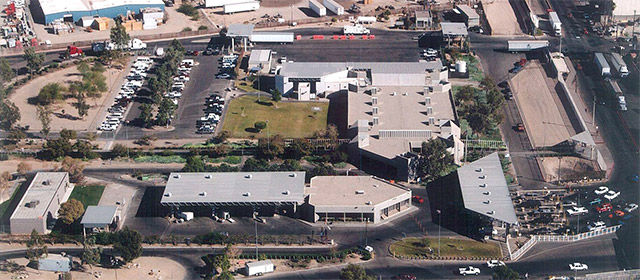GSA details $300+ million in capital projects and retrofits at federal facilities to cut energy and carbon

San Luis Port of Entry. Image courtesy of GSA
Capital projects and retrofits at federal facilities aim to spur emerging clean energy technologies and boost demand for low-carbon construction materials
The U.S. General Services Administration recently announced more than $300 million in construction and renovation projects funded through the Inflation Reduction Act, which President Biden signed in August. This first set of projects aims to catalyze clean energy innovation and spur domestic clean manufacturing by incorporating emerging technologies and low-carbon materials into construction and renovation projects at federal facilities across America. The funds, the first of $3.4 billion in GSA investments, will also accelerate efforts to achieve President Biden’s goal of a net-zero emissions federal building portfolio by 2045.
Administrator Robin Carnahan announced the projects during a visit to the San Luis I Land Port of Entry in Arizona, which will undergo a modernization and expansion with funding from both the Inflation Reduction Act and the Bipartisan Infrastructure Law. The former will provide approximately $100 million, allowing the project to plan for LEED Platinum certification and incorporate low-embodied carbon asphalt, concrete and steel, as well as emerging technologies and other measures to improve efficiency and reduce operational emissions. The project will improve traffic flow, increase operational security, and help agencies better address risks, combat drug trafficking, and more.

The Inflation Reduction Act gives us a historic opportunity to supercharge GSA’s efforts to spur clean energy innovation and boost demand for cleaner, more sustainable construction materials manufactured right here in the United States. These projects will create good jobs in communities and put us another step closer to turning federal facilities in San Luis and across the country into high-tech, high-efficiency models of clean energy innovation.
GSA Administrator Robin Carnahan
Administrator Carnahan also visited Solterra Materials LLC, in Buckeye, Arizona, which supplied environmentally preferable asphalt for GSA’s first completed Bipartisan Infrastructure Law project in June at another LPOE in Lukeville, Arizona. The San Luis and Lukeville projects are aligned with the Biden-Harris Administration’s Buy Clean Initiative, which promotes American-made construction materials with lighter environmental footprints.
Thanks to President Biden’s Inflation Reduction Act, we’re moving forward on the clean, electrified federal buildings of tomorrow. As our country’s largest energy consumer, taking bold action to modernize the way we build, buy, and manage federal operations creates good paying jobs in places that need them and helps us reach our nation’s climate goals.
White House Federal Chief Sustainability Officer Andrew Mayock
U.S. Senators Kyrsten Sinema and Mark Kelly worked to help secure the funding. Senator Sinema noted the the historic investments will help “strengthen Arizona’s border security and keep our communities safe and secure,” and Senator Kelly stated that “our border personnel will be better equipped to expedite cross-border travel and trade while stopping illegal cargo.”
These first Inflation Reduction Act projects were selected based on their potential to maximize the use of low-embodied carbon asphalt, concrete, glass and steel — as well as emerging and sustainable technologies — in previously-approved construction projects. GSA estimates that this first round of projects will help reduce greenhouse gas emissions by about 120,000 metric tons while reducing energy costs by $35 million over the next 20 years.
In addition to the San Luis Land Port of Entry project above, these projects are slated to receive Inflation Reduction Act funding as part of this initial round:
- Federal Center HHS-FDA Laboratory — Lakewood, CO. To replace an aging laboratory, approximately $80 million will go toward building a new, all-electric, high performance laboratory that will reduce carbon dioxide emissions and use energy saving technologies like recapturing otherwise wasted heat from chillers. The site aims to be net zero with extensive use of solar panels. GSA is evaluating software controlled switch reluctance motors, a technology identified by the GSA Green Proving Ground program, for this project.
- John C. Kluczynski Federal Building — Chicago, IL. GSA plans to consolidate the Department of Health and Human Services (HHS) entire Chicago real estate portfolio into two locations, the Kluczynski Federal Building and the nearby Ralph H. Metcalfe Federal Building, reducing their space by over 50 percent. The consolidation is expected to save HHS over $3.5 million in annual rent costs and dramatically improve space utilization. More than $3 million in Inflation Reduction Act funds will support new low-embodied carbon flat glass and other improvements. New technologies being evaluated include occupancy sensors and tubular LED lighting.
- Edward T. Gignoux U.S. Courthouse — Portland, ME. More than $3.2 million will support the Gignoux Courthouse renovation project with low-embodied carbon materials and emerging technologies. The overall project will repair and replace the building’s deficient heating, ventilation and air conditioning (HVAC) system, as well as the fire alarm system, with a new efficient system that reduces carbon and saves energy. GSA plans to install air-to-water heat pumps which will help convert the building’s HVAC system to all-electric power.
- Patrick V. McNamara Federal Building — Detroit, MI. The project will receive approximately $24 million to complete critical structural and related system upgrades to a rapidly deteriorating parking garage. The funding will allow for the incorporation of low-embodied carbon materials (asphalt, concrete and steel) and emerging technologies. GSA is studying converting the garage’s HVAC system to all-electric power and incorporating electric vehicle charging infrastructure.
- Charles Evans Whittaker U.S. Courthouse — Kansas City, MO. This project will receive $61 million for materials to help the Whittaker Courthouse project reduce its embodied carbon footprint while improving efficiency and tenant satisfaction. GSA will replace the deteriorating curtain wall, including windows and seals. GSA plans to install new low-embodied carbon glass windows over 100,000 square feet of curtain wall.
- Frank E. Moss U.S. Courthouse — Salt Lake City, UT. More than $23 million will go to the Frank E. Moss U.S. Courthouse for low-embodied carbon materials and other improvements. The overall project will: address seismic and structural deficiencies; upgrade mechanical and HVAC systems; provide new and repaired floor, wall and ceiling finishes in areas impacted by seismic retrofits; and address electrical and lighting issues. GSA will then move federal agencies from leased space into this building. As part of this project, GSA is evaluating converting the entire building to all-electric power, and making this a net-zero operational emissions building.
- Lewis F. Powell, Jr., U.S. Courthouse — Richmond, VA. With an investment of approximately $7 million, the Powell Courthouse renovation project seeks to incorporate low-embodied carbon glass to repair and replace windows, eliminate leaks, and increase energy efficiency. Those upgrades will help avoid over 1,400 metric tons of emissions — equivalent to taking 300 cars off the road. The overall project involves replacement and repair of deteriorated components of the roof, gutters and storm drain pipes to eliminate leaks and stop resulting interior damage, while adding fall protection safety features.
GSA also plans to use Inflation Reduction Act funding for two investments totaling about $18 million for Energy Savings Performance Contracts (ESPCs) that support deep energy retrofits for several federal buildings. These investments will leverage private sector funding to catalyze a total investment of about $38 million, and are estimated to save taxpayers about $55 million over their performance periods.
- Projects at 12 federal buildings in Louisiana and Texas aim to include energy conservation measures such as new chillers, chiller improvements, high efficiency transformers, heating, ventilation and air conditioning (HVAC) system improvements, building automation system enhancements, solar panels, and new window insulation panels. These projects aim to reduce greenhouse gas emissions by an estimated 34 percent or over 6 million metric tons.
- Projects at four federal buildings in Ohio plan to include energy conservation measures such as lighting upgrades, chiller and electric boiler replacements, and building automation system enhancements. These projects target reducing greenhouse gas emissions by an estimated 30 percent or over 1.5 million metric tons.
Overall, the Inflation Reduction Act provides GSA with $2.15 billion for low-embodied carbon materials for construction projects; $975 million to support emerging and sustainable technologies; and $250 million for measures to convert federal facilities into High Performance Green Buildings.
GSA estimates that the $3.4 billion it will invest will create over 9,500 average annual economy-wide jobs across the length of the projects, support $2.8 billion in labor income, and generate nearly $1 billion in tax revenue for federal, state and local governments. In total, Inflation Reduction Act investments from GSA are expected to help drive an estimated avoidance of more than 2.5 million metric tons of emissions and $720 million in cost avoidance over the next 20 years.
To read more about GSA and the Inflation Reduction Act, visit GSA.

